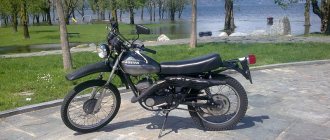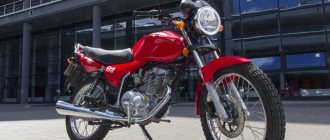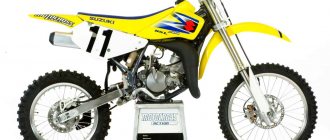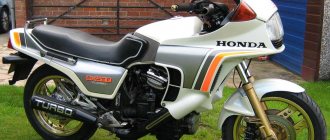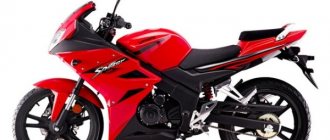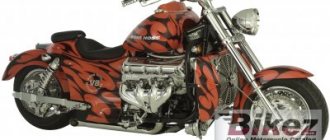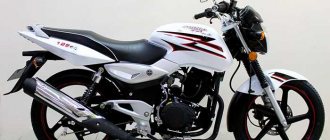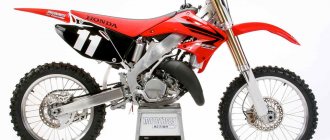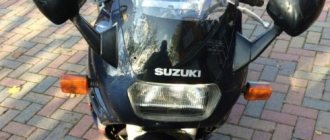It is no secret that some of the products of many brands are assembled in China. Sometimes manufacturers rent separate workshops and conveyors, and some build entire assembly plants. Honda is not building the first plant in the Middle Kingdom. Already operating enterprises assemble several motorcycles of the brand, and at the same time, with the consent of the Japanese, they make bikes under their own label. The representative of such a statement is Nanfang.
The Nanfang NF 250 model almost completely copies the Honda CBR250R.
Nanfang NF 250 (250-8A) - Chinese sports Honda
It is no secret that some of the products of many brands are assembled in China. Sometimes manufacturers rent separate workshops and conveyors, and some build entire assembly plants. Honda is not building the first plant in the Middle Kingdom. Already operating enterprises assemble several motorcycles of the brand, and at the same time, with the consent of the Japanese, they make bikes under their own label. The representative of such a statement is Nanfang.
The Nanfang NF 250 model almost completely copies the Honda CBR250R.
Design
The front suspension is based on a conventional telescopic fork.
Most of the parts of the motorcycle were developed by Japanese engineers. .
The frame is steel, diagonal. The rigidity is not bad, but it was achieved not by casting, but by a metal thickness of 37 mm.
The suspension was not redeveloped. The front wheel is mounted on a conventional telescopic fork with a working stroke of 118 mm. For the rear there is a standard monoshock absorber. Its working stroke is 104 mm .
Otherwise, the outline, a large amount of body kit, and the location of individual blocks repeat the developments of the Japanese.
Exterior
An interesting feature of some models is the presence of inscriptions and stickers with Honda symbols. Users note that this is not an appearance tuning - this is how the new bike is offered for sale.
And although there are no special differences in the design, the electrical wiring is done differently.
A large amount of plastic body kit was also passed down from the Japanese. But the strength of the plastic leaves much to be desired . Even an unsuccessful jump from the curb can lead to cracks.
Front end
The appearance of the motorcycle indicates that it belongs to the sports class.
The wing is pressed as close as possible to the tire.
The gap between the plastic of the front part and its surface is medium in size, but when purchasing it is recommended to strengthen the area where the fender meets the fork.
- The headlight is double and shines well . It is only set to high beam. The role of the neighbor is played by a pair of small light bulbs, which are also located behind the headlight glass. The glass itself exactly follows the curve of the front body kit, so when viewed from the side you get the impression of two lights.
The direction indicators are mounted on external brackets.
Dashboard
The difference between the Japanese and Chinese panels is immediately visible. While Japanese engineers used an LCD display, Nanfang has this unit as standard.
The motorcycle “tidy” is equipped with dial indicators.
The specially shaped overall glass hides a large speedometer dial, which has both kilometer and mile markers. Just below it, in two semi-arcs, are fuel and speed indicators. There are small turn indicators on the sides of the block. The standard odometer is a digital line on the top of the speedometer. There are no other signs.
“Chekushki” from the Middle Kingdom: Chinese motorcycles 250 cm³
250 cc motorcycles are far from “study desks”, but also not “battering weapons” such as powerful sportbikes or heavy choppers, which require experience and certain physical characteristics to operate.
000_moto_0611_044
Once upon a time, the word “chekushka” was in use - this was the name for a 250-gram bottle of vodka that cost only 1 ruble. 49 kopecks - for one and inexpensive, and without going overboard. Motorcyclists associated the “check” with the Jawa 250 motorcycle - not as expensive as the top model Jawa 350, for which they fought in queues, but no longer an unfinished Soviet product. In general, the “check” meant a budget alternative. Today, perhaps, it’s time to remember the old word: let’s see what kind of “checks” we have from the Middle Kingdom. In our market, the “250” class is represented mainly by Chinese companies that have relatively recently grown into such engines - previously they were producing 125-150-200 cm³ cubic capacity, producing clones of the Honda CG series lower engine. Several types of engines already serve as prototypes for “checks,” and they are much more diverse.
SPORTBIKES
In general, the R 250 can only conditionally be attributed to the Chinese motorcycle industry: the concept belongs to the British company Megelli, the design was created by Italian craftsmen, and only the components are from China. The beauty of the bike, which is not hidden by the fairing, is the birdcage space frame, like on Ducati. The second feature is an openwork pendulum, spied on by another world grandee - Benelli, and it is made of aluminum alloy. The muffler, as has become fashionable, is in the center, protruding from under the passenger side of the seat. There is also no shame in the engine, which is hidden in the depths of the device: it is liquid cooled, produces as many as 26 “horses” and is linked to a six-speed gearbox. The motorcycle sits on 17-inch alloy wheels equipped with petal brake discs. True, there is only one disc at the front, but it has a record diameter of 300 mm for the class.
001_moto_0611_044
The Patron Sport 250 (offered by Ural Motorcycle Company LLC from Izhevsk) in its sportbike guise demonstrates the increased capabilities of the Chinese motorcycle industry. The single-cylinder, four-stroke, air-oil-cooled engine (233 cm³) is equipped with a balancer shaft, an electric starter and is linked to a five-speed gearbox. There are disc brakes on both 17-inch wheels, but the suspension settings are not the best.
002_moto_0611_044
The veteran of our market - Zongshen Winner ZS250GS - has not lost its attractiveness. On a vehicle equipped with a semi-fairing and clip-ons, the driver takes a characteristic semi-recumbent position, the tachometer is located in the center of the instrument panel. The motor is a single-barrel air vent with an enduronic power curve. The brakes on both wheels are disc, with two discs at the front. The chassis features 17-inch wheels, an inverted fork and a rear suspension with a progressive linkage system (alas, without any adjustments). Among the features worth noting are the fuel level indicator on the dashboard and the absence of any cavities for tools. Starting the engine is only possible with an electric starter. The 17-horsepower engine accelerates the motorcycle to 120 km/h. This device has a good reputation of its Chinese “father” - China Zongshen Motorcycle Group Co., Ltd., one of the largest companies in the world.
003_moto_0611_044
NAKED SKIDS
004_moto_0611_044
Similar to Minsk in everything except price, brand and some little details - Sagitta SNS250 Jedi. Our Italian-sounding brand is Russian (fifth year on the market). Another difference is the colors offered: if “Minsky” comes in red and black, then “Sagitta” is red and radically black.
Rear end
An LED brake light is mounted under the passenger seat.
- The rear turn signals are no different from the front ones . The same “ candles ”, one side of which is hidden with transparent glass, the other with plastic. The mounting is also similar, on external stands.
- Stop and clearance behind one glass, on the mudguard . The light bulbs are located in the corners, with several reflectors between them. The location and angle of rotation of the latter are carefully calculated. When any of the bulbs is turned on, the headlight is illuminated evenly and very brightly.
The rear optics shine quite brightly.
Specifications
Despite the fact that the motorcycle was manufactured by the Chinese, the vehicle passport indicates that the engine is Japanese. When comparing the characteristics, common features with the Japanese version are discerned.
The engine has 4 strokes, 1 piston:
- working volume - 248 cm 3;
- power - 16 hp;
- number of valves - 2;
- cooling - air;
- fuel supply - carburetor;
- ignition - electronic;
- start - electric starter;
- fuel tank - 13 l.
According to user reviews , the motor is calm and does not cause problems if properly maintained .
Unlike the Japanese version, it starts without problems even in cold weather (down to -5).
Flaws
What disadvantages can a Chinese motorcycle have? Mechanics answer this question briefly - build quality .
Sometimes they add - immediately after purchase, have it serviced, but not in a garage, but at a good service station. For several years, no problems are guaranteed.
and dignity
- Price . Unlike Japanese powerful sportbikes, whose cost starts from 100,000 rubles on the secondary market, the Chinese have a price of half, and sometimes even less.
- Fuel consumption . In relation to this model, fuel consumption can also be called a plus.
Driving performance
A driver of average height will be most comfortable on a motorcycle.
The maximum speed according to the passport is 140 km/h.
Users notice that the figure is overestimated. Comfortable cruiser - 80 km/h . If you want to anneal, you can squeeze out 120 km/h, if you remember that after 100 there is a sharp drop in power.
Acceleration to hundreds
At the start, the engine quickly picks up speed to 80, but accelerates to 100 km slowly - 9 seconds.
“Chekushki” from the Middle Kingdom: Chinese motorcycles 250 cm³
250 cc motorcycles are far from “study desks”, but also not “battering weapons” such as powerful sportbikes or heavy choppers, which require experience and certain physical characteristics to operate.
000_moto_0611_044
Once upon a time, the word “chekushka” was in use - this was the name for a 250-gram bottle of vodka that cost only 1 ruble. 49 kopecks - for one and inexpensive, and without going overboard. Motorcyclists associated the “check” with the Jawa 250 motorcycle - not as expensive as the top model Jawa 350, for which they fought in queues, but no longer an unfinished Soviet product. In general, the “check” meant a budget alternative. Today, perhaps, it’s time to remember the old word: let’s see what kind of “checks” we have from the Middle Kingdom. In our market, the “250” class is represented mainly by Chinese companies that have relatively recently grown into such engines - previously they were producing 125-150-200 cm³ cubic capacity, producing clones of the Honda CG series lower engine. Several types of engines already serve as prototypes for “checks,” and they are much more diverse.
SPORTBIKES
In general, the R 250 can only conditionally be attributed to the Chinese motorcycle industry: the concept belongs to the British company Megelli, the design was created by Italian craftsmen, and only the components are from China. The beauty of the bike, which is not hidden by the fairing, is the birdcage space frame, like on Ducati. The second feature is an openwork pendulum, spied on by another world grandee - Benelli, and it is made of aluminum alloy. The muffler, as has become fashionable, is in the center, protruding from under the passenger side of the seat. There is also no shame in the engine, which is hidden in the depths of the device: it is liquid cooled, produces as many as 26 “horses” and is linked to a six-speed gearbox. The motorcycle sits on 17-inch alloy wheels equipped with petal brake discs. True, there is only one disc at the front, but it has a record diameter of 300 mm for the class.
001_moto_0611_044
The Patron Sport 250 (offered by Ural Motorcycle Company LLC from Izhevsk) in its sportbike guise demonstrates the increased capabilities of the Chinese motorcycle industry. The single-cylinder, four-stroke, air-oil-cooled engine (233 cm³) is equipped with a balancer shaft, an electric starter and is linked to a five-speed gearbox. There are disc brakes on both 17-inch wheels, but the suspension settings are not the best.
002_moto_0611_044
The veteran of our market - Zongshen Winner ZS250GS - has not lost its attractiveness. On a vehicle equipped with a semi-fairing and clip-ons, the driver takes a characteristic semi-recumbent position, the tachometer is located in the center of the instrument panel. The motor is a single-barrel air vent with an enduronic power curve. The brakes on both wheels are disc, with two discs at the front. The chassis features 17-inch wheels, an inverted fork and a rear suspension with a progressive linkage system (alas, without any adjustments). Among the features worth noting are the fuel level indicator on the dashboard and the absence of any cavities for tools. Starting the engine is only possible with an electric starter. The 17-horsepower engine accelerates the motorcycle to 120 km/h. This device has a good reputation of its Chinese “father” - China Zongshen Motorcycle Group Co., Ltd., one of the largest companies in the world.
003_moto_0611_044
NAKED SKIDS
004_moto_0611_044
Similar to Minsk in everything except price, brand and some little details - Sagitta SNS250 Jedi. Our Italian-sounding brand is Russian (fifth year on the market). Another difference is the colors offered: if “Minsky” comes in red and black, then “Sagitta” is red and radically black.
005_moto_0611_044
006_moto_0611_044
New for 2011 - Patron Taker 250 - made in the style of classic street fighters, there is something from the Suzuki Bandit in it. True, in terms of seat ergonomics, the Chinese were on the passenger side - there is no narrow slope. The single-cylinder four-stroke engine (25 hp) is charged with liquid cooling, a balancer shaft, a four-valve cylinder head with two overhead camshafts, and a six-speed gearbox. The maximum speed of the vehicle is 140 km/h, and good stopping power is provided by two front brake discs with a diameter of 300 mm. The name of the real manufacturer is Yingang (Chongqing Yingang Sci & Tech Co., Ltd), it doesn’t mean much even to a specialist, but the motorcycle turned out to be truly outstanding.
007_moto_0611_044
The Kinlon JL250F is also designed with an eye to the streetfighter class - similar fit, clip-ons, and tank cover. There is a tachometer on the dashboard, the brake reservoir is made in the form of a can. The motorcycle brakes are disc brakes, with two discs at the front, an inverted front fork, and rear wheel suspension with two backpack shock absorbers. Looking at the large and heavily chromed engine, you don’t immediately notice its feature - two-cylinder. This design feature (a cloned legacy of the Honda SV series) makes the device more “fun” on the move than conventional single-barreled guns, although the power is moderate - 17 “horses”, and the maximum speed is 105 km/h. The Chinese manufacturing company is part of the Geely Group and has seven years of experience in producing motorcycles.
008_moto_0611_044
ENDURO. The offer in this type of cubic capacity “250” is constantly expanding. Apparently, in those places where they are really needed (and this is a poor province), when you need to drive on real off-road conditions, branded show-offs fade into the background. After all, the kings of the provinces of yesteryear, the indestructible “Minsky” and “IZhi”, cannot be on the move forever!
A new brand with a star name - Sky Team. Actually, this is Jiangsu Sacin Motorcycle Co., Ltd., a relatively young (since 1999) Chinese company, known in the world for its clones of Honda “Cab” babies like Monkey, Dax, Gorilla. In general, the Sky Team ST250TR does not stand out from the average Chinese enduro, but nevertheless attracts with its harmonious appearance. It's no-frills, allowing it to fit in at 135kg dry weight, while it's equipped with 21/18-inch wheels, a robust luggage rack and a full range of lighting equipment. The air-cooled motor is from the past; it is simple and well developed by Chinese manufacturers. There are no special bells and whistles, except for an inverted fork and brakes with petal discs. There is almost no aluminum in the chassis, the suspension is without adjustments, but there is high ground clearance and “toothy” tires.
009_moto_0611_044
But the Sky Team ST250–2 V-Raptor model is extremely curious - in it, the “Sky Team” (as the name is translated) actually quail the narrow-haired VanVan 125 (sellers claim that a license was purchased). But if the original, which has been popular since 2002, has a fairly advanced injection vent connected to a 6-speed gearbox, then “ours” (the Chinese) have a regular engine and a 5-speed gearbox. Yes, and it’s only a stretch to classify this motorcycle as an enduro class, it’s just that it’s closer here than to any other class. Off-road use primarily requires wide tires, especially the rear ones, as well as an upper muffler and greater than average ground clearance. The spacious and low seat (in addition, it is wide in the rear, like a sofa) in combination with a significant wheelbase promise comfortable travel. The motorcycle is also distinguished by a convenient luggage rack behind the seat, rubber-coated footrests, and that careful attention to detail that the Japanese are famous for. The price factor is also important: the Chinese clone is almost half the price of the “Van Vanych”, despite the fact that it has a larger engine, which, although not high-tech with injection, is still more powerful than the “Japanese” by two and a half “horses”.
010_moto_0611_044
New for the season is the C.Moto 250 4V sports enduro with a fast design. The equipment is from the Middle Kingdom, the brand is St. Petersburg, and also has a rich history: mopeds were once produced at the state aviation enterprise Leningrad Northern Plant. The proposed device is one of the most advanced in its class: with a modern liquid-cooled engine with a four-valve twin-shaft cylinder head, which provides the maximum power among Chinese “checks” (32.6 hp). The chassis features an inverted fork and an adjustable monoshock absorber, providing 300 mm of wheel travel. It is noteworthy that the suspensions have a full set of adjustments. The motorcycle is offered in Offroad versions on 21/18-inch off-road tires and Motard - a road version on 17-inch wheels.
011_moto_0611_044
A year ago, the Patron Strike 250 replaced the 200 cc model of the same name, one of the most attractive Chinese-made enduros on our market. The new product has a different air-cooled engine (with an overhead camshaft, not an OHV design) and a completely redesigned appearance: functional wings and fender liners, a front protective yoke, engine protection from below, and durable handles on the sides of a 2-seater saddle. Full-fledged lighting technology allows you to move on public roads at a maximum speed of 100 km/h even at night. The motorcycle is equipped with disc brakes on both wheels, tires with classic sizes of 21/18 inches with “evil” off-road tires, and the rear suspension also has a linkage system. True, there are no suspension adjustments. Additionally, a set of wheels is offered: replacing them with 17-inch road wheels and changing the suspension settings allows you to change the orientation of the device to the Motard one.
012_moto_0611_044
The domestic company Irbis, which has been selling scooters from Chinese companies for seven years, has expanded its niche. The new Irbis TTR 250 model is a fairly tough endurik (not in terms of suspension characteristics, but in terms of off-road capability). The device is extremely light, with “toothy” tires measuring 21/18 inches and significant ground clearance. Long-travel suspensions are made without much effort in terms of adjustments. There is also lighting technology, although it is rather formal. The main advantage of the motorcycle is its budget. This is the cheapest motorcycle with a 250 class engine on our market.
013_moto_0611_044
CRUISERS
One of the surviving veterans is the Lifan LF250, a fairly accurate copy of the early version of the Yamaha Virago. The engine is a classic V-twin design, mated to a 5-speed gearbox. The motorcycle is not designed for racing and is unlikely to go faster than 100 km/h, but it stands well on the road, since Japanese choppers, unlike American ones, gave priority to ride quality. Although China's largest private motorcycle manufacturer, Lifan Group Co., Ltd. There is also a 400 cc copy of the “witch” in the bins (test in “Moto” No. 4–2010), according to the sellers, the “chekushka” wins the competition in the “price-quality” discipline.
Dimensions and weight
Regarding the weight of the company’s motorcycles, there is a saying that “another girl is heavier to carry than him.” At the same time, the passport indicates 139 kg .
External parameters make this bike stand out compared to many competitors in its class:
- length - 1980 mm ;
- width - 570 mm ;
- height - 1100 mm .
- seat height - 760 mm .
Ground clearance and wheelbase are completely copied from Honda - 145 and 1370, respectively.
There is enough ground clearance for comfortable movement in urban environments.

